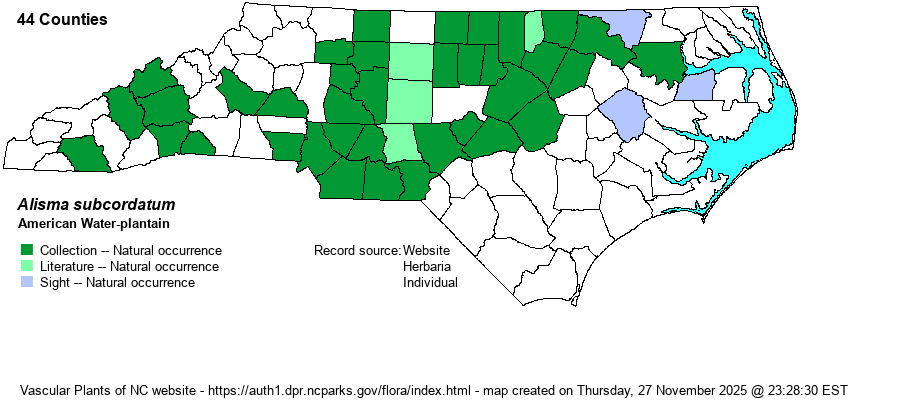| Author | Rafinesque | |
| Distribution | Scattered over the Piedmont, much of the Mountains, and the northwestern Coastal Plain. Absent from the Sandhills proper, the southern half of the Coastal Plain, and some coastal counties. Perhaps also absent from the northern Mountains.
This species has a wide range, across southeastern Canada and south to central GA and eastern TX.
| |
| Abundance | Uncommon to infrequent across most of the Piedmont and northwestern Coastal Plain. Uncommon in parts of the southern Mountains, but very rare to absent in the northern portion. | |
| Habitat | This is a species of bare mud, such as in marshes or edges, openings or roadbeds in bottomlands, muddy edges of streams, or impoundment margins. |
| Phenology | Blooms for much of the growing season, between April and November, and fruits shortly after flowering. | |
| Identification | This is a marsh species with large leaf blades, like quite a few other monocot species. The leaf stalk is very long, often 6-10 inches long, topped by a large ovate to elliptical blade that averages 6 inches long and 4 inches wide, with a slightly cordate base. There are a handful of such leaves per plant, which also has a flowering scape often to 2 feet long, with the upper third being a very large panicle of whorled branches. Tiny triangular (three-petaled) white flowers, only 1/4-inch across or less, tip the many branches, giving the inflorescence a very open and nearly naked appearance. The leaf alone, with the very long stalk and a widely elliptic blade, is usually good enough for identification, but if the flowering stalk is seen, then it is unmistakable. Sometimes you can find this species growing along a muddy portion of a greenway, or in a deep tire track in a muddy road, as the species does well in small very muddy spots. It is surprising why this species isn't more widespread in the state, as it is found in common sunny wetland habitats. | |
| Taxonomic Comments | A few references name it as Alisma plantago-aquatica.
| |
| Other Common Name(s) | Southern Water-plantain, Broadleaf Water-plantain, Common Water-plantain | |
| State Rank | S3 [S4] | |
| Global Rank | G5 | |
| State Status | | |
| US Status | | |
| USACE-agcp | OBL link |
| USACE-emp | OBL link |

